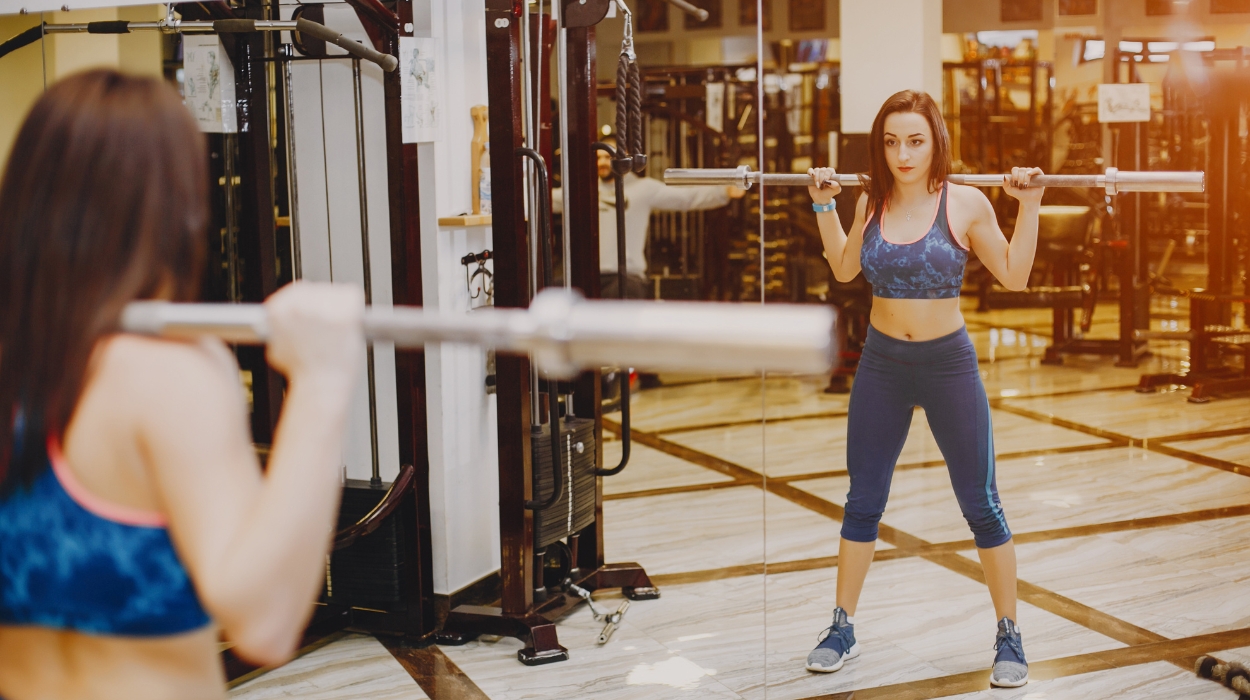
If fat loss is your goal, you might be surprised to find out that heading to the weight room could be your best strategy! Why? Because strength training for weight loss is scientifically proven to burn fat,[1] both during exercise and at rest[2] (by raising your metabolic rate). In fact, it boasts many other physical[3] and mental health benefits that cardio alone simply can’t provide.
Not sure where to begin? No worries. We’ll give you the low down on which resistance exercises are best to lose weight (at home or the gym) for beginners and more advanced athletes. We will even start you off with a great strength training routine (that you can adapt as you include the use of supersets), alongside sharing many other surprising benefits of weight training for females (including how it can help counter postmenopausal symptoms and painful periods).
5 Best Sample Exercises Of Resistance Training For Weight Loss
Best Strength Training For Weight Loss
So if you’re looking to accelerate fat-burning goals and build more lean mass, check out our top five strength exercises for body weight loss (below), then read on to discover how to incorporate them into a straightforward yet effective routine.
Squats
The squat is often regarded as the king of the weight room when it comes to strength training and for a good reason. That’s because any compound posterior chain exercise like a squat (i.e., that hits multiple large muscle groups at once) will get great results. Squats work major muscle groups like your latissimus dorsi, core abdominal muscles, glutes, hamstrings, quadriceps, and calves, and they have been shown to cause a significant decrease in body fat.[4] They can be performed against a wall, with weights, as squat jumps, or as a bodyweight-only exercise.
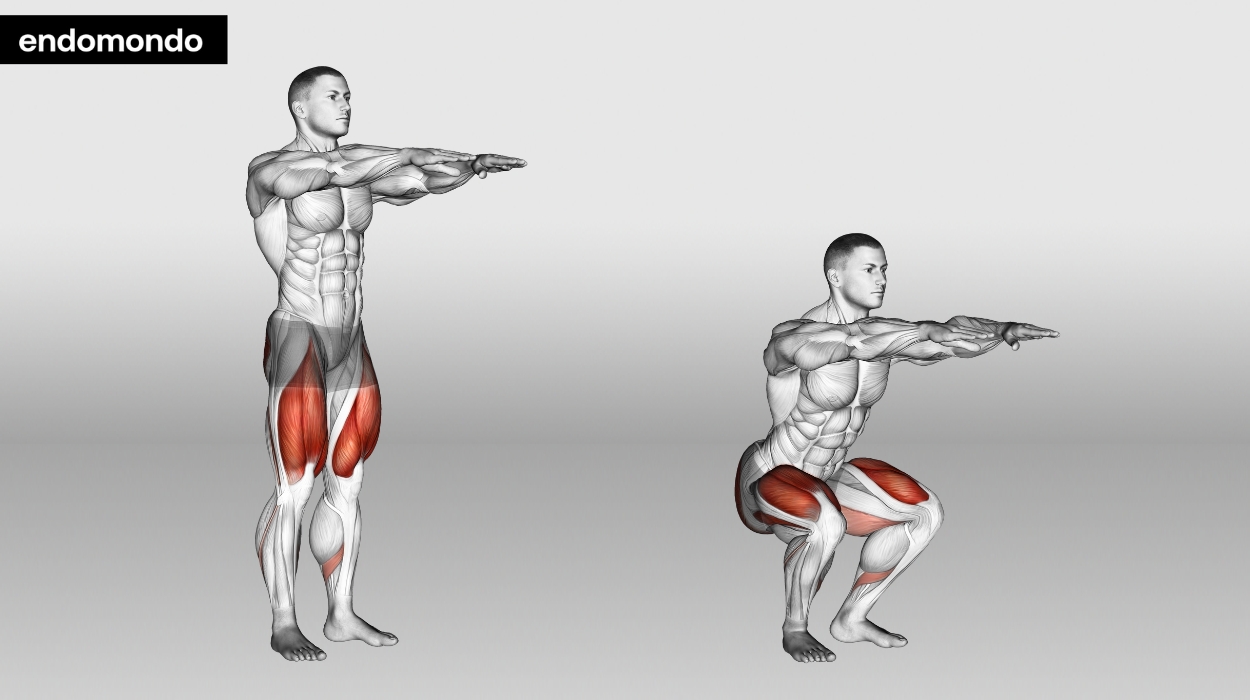
How to do:
- Stand with your feet shoulder-width apart, toes pointing slightly outward.
- Keep your chest up, shoulders back, and core engaged.
- Begin the squat by pushing your hips back and bending your knees.
- Lower your body as if you’re sitting back in a chair, ensuring your knees stay aligned with your toes.
- Go as low as your flexibility allows or until your thighs are parallel to the ground.
- Press through your heels and engage your glutes to return to the starting position.
Tips:
- Focus on controlled descent and ascent, avoiding sudden or jerky movements during squats.
- Keep your knees in line with your feet to prevent unnecessary stress on the joint.
- Don’t round your lower back; maintain a neutral spine position throughout the exercise.
Optimal Sets and Reps: 3-5 sets of 12-15 reps.
Deadlifts
Another powerful posterior chain exercise, the deadlift targets multiple muscles in the back, shoulders, core, and legs, increasing lean muscle mass and burning more calories. Efficient compound strength exercises like the deadlift also boost post-exercise oxygen consumption[5] far more than if you engaged in aerobic exercise (meaning that you’ll burn more fat while at rest).
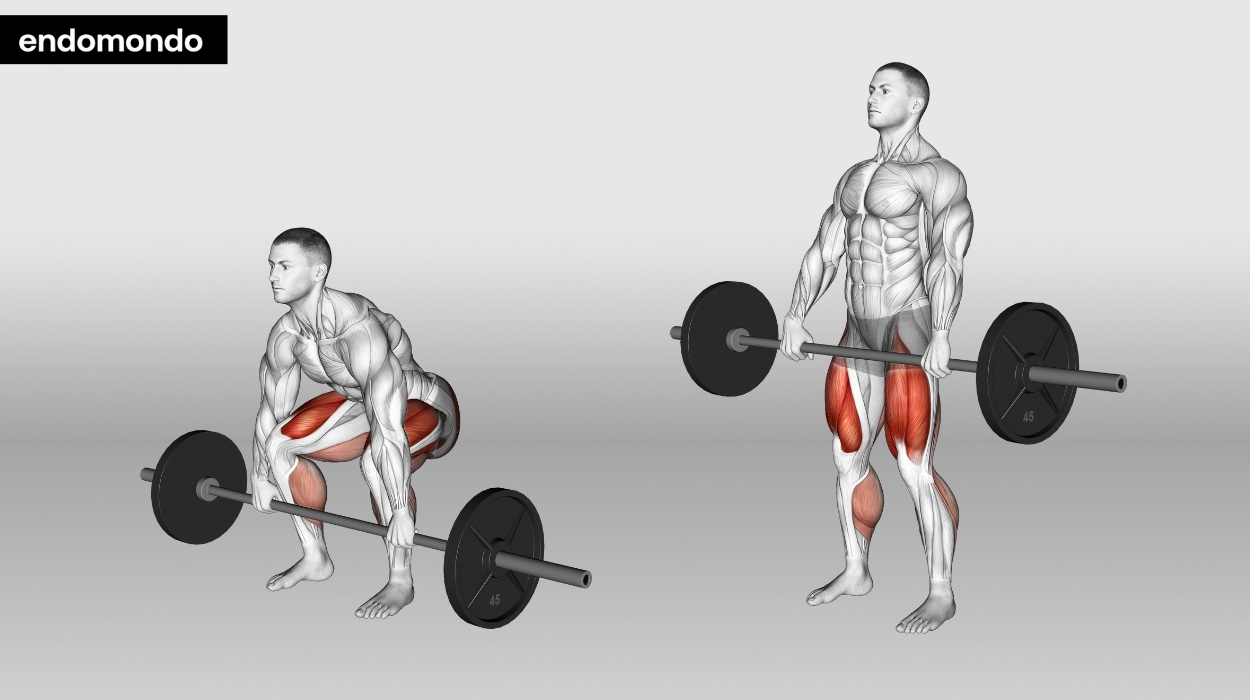
How to do:
- Stand with your feet hip-width apart, toes pointing forward, and a barbell over the middle of your feet.
- Bend at your hips and knees to lower your body, keeping your chest up, back straight, and a neutral spine.
- Grip the barbell with both hands slightly wider than shoulder-width apart, using an overhand or mixed grip.
- Brace your core, engage your lats, and drive through your heels to lift the bar, straightening your hips and knees.
- Keep the bar close to your body as you stand up, maintaining a straight back.
- Once standing fully upright, reverse the motion by pushing your hips back and lowering the barbell to the ground under control.
Tips:
- Maintain a neutral spine throughout the lift, avoiding rounding or excessive arching.
- Begin with lighter weights to ensure you can maintain the correct technique before lifting heavy.
- Focus on driving through your hips and legs, rather than using your lower back, to avoid injury.
Optimal Sets and Reps: 3-5 sets of 12-15 reps.
Press-ups
For sculpted Michelle Obama arms, press-ups are a great choice, enabling you to show off your weight loss to the max. They target the pectorals (chest muscles), triceps, deltoids (shoulders), and many mid and upper back muscles.
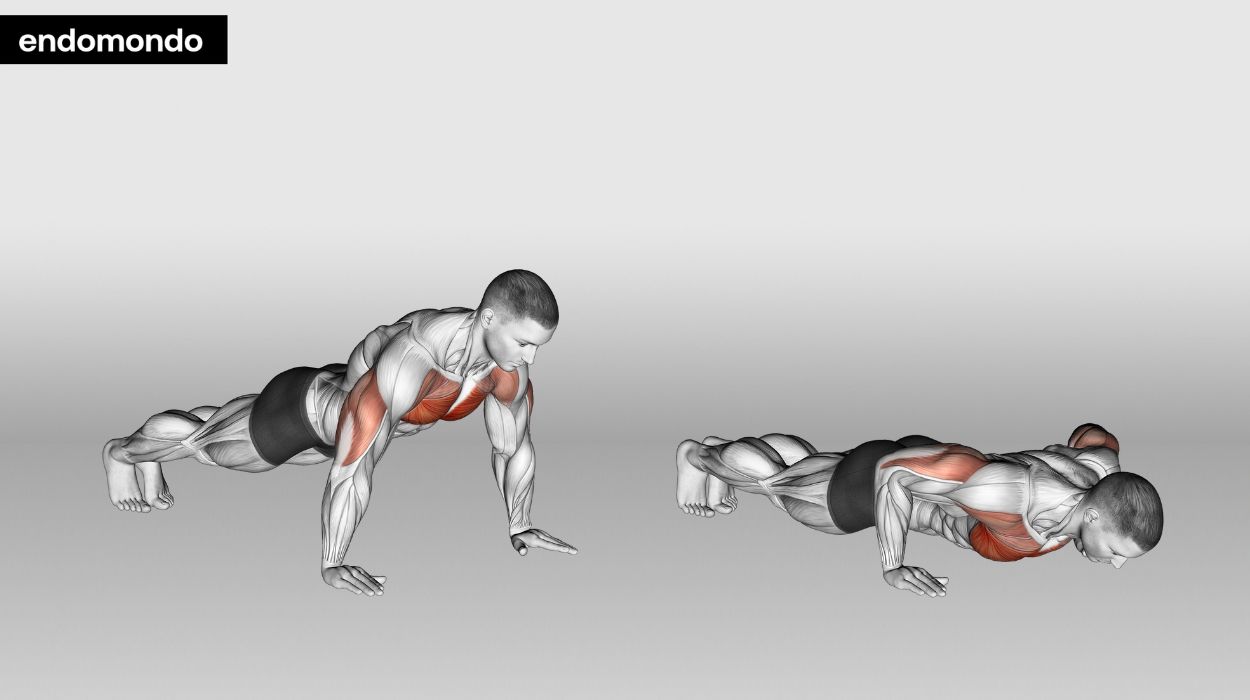
How to do:
- Start in a plank position with your hands placed slightly wider than shoulder-width apart, fingers pointing forward.
- Keep your body in a straight line from head to heels, engaging your core and glutes.
- Lower your chest towards the ground by bending your elbows, keeping them close to your body.
- Go as low as your chest hovers just above the floor or mat.
- Push through your palms to extend your arms fully and return to the starting position.
Tips:
- Keep your body in a plank position to avoid arching or sagging your back.
- Ensure your elbows are at a 45-degree angle from your body to protect your shoulders.
- Begin with knee push-ups or wall push-ups if regular push-ups are too challenging, then progress to full push-ups.
Optimal Sets and Reps: 3-5 sets of 12-15 reps.
Plank
While many people burn through countless situps in a bid to gain a six-pack, what they really should be doing is a plank. Why? Because a plank will cinch in the waist by targeting the internal abdominals[6] (the transversus abdominis) – much like tightening a belt would do. The visual effect over time is a smaller waist, alongside the overall strengthening of the core.
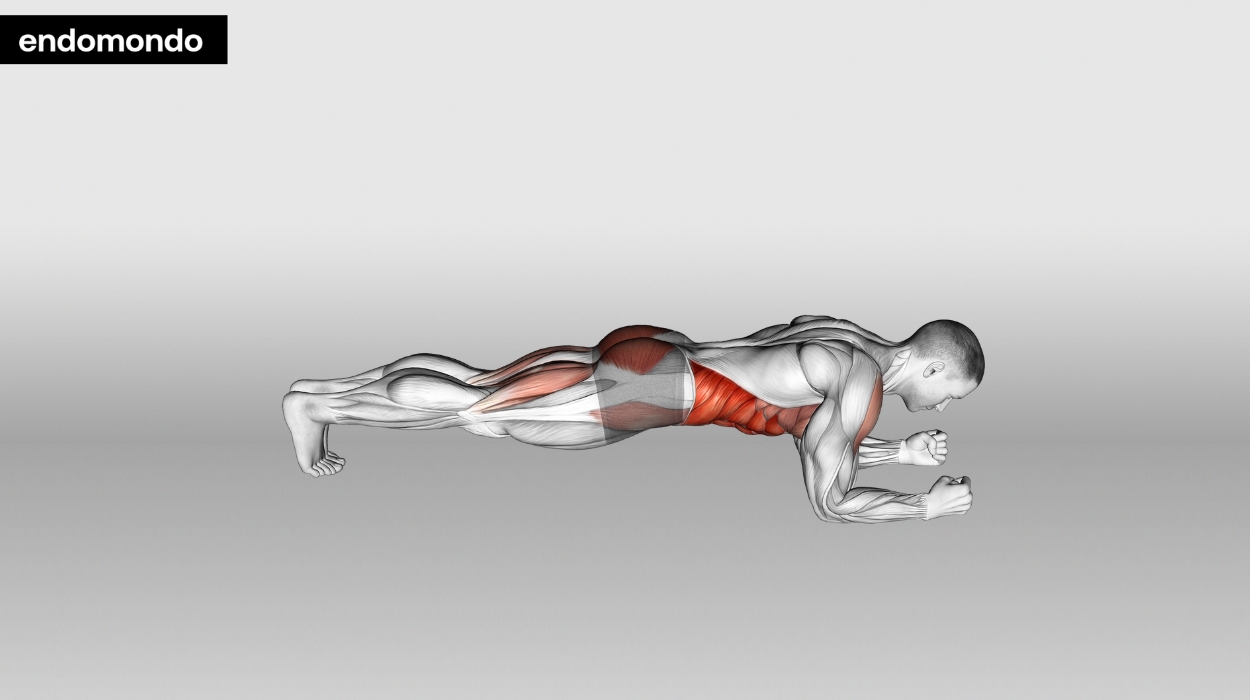
How to do:
- Begin in a prone position on the floor with your elbows directly under your shoulders.
- Rest your forearms on the ground, palms facing down, and fingers pointing forward.
- Extend your legs straight behind you, toes tucked under, and engage your core.
- Lift your body off the ground, creating a straight line from head to heels.
- Keep your neck in a neutral position, looking down at the floor, and hold this position.
Tips:
- Contract your buttocks to help stabilize your hips and maintain a straight line from head to heels.
- Balance your weight between your elbows and forearms, ensuring equal pressure on both sides to avoid imbalances or discomfort.
- Don’t hold your breath; breathe deeply and evenly while holding the plank position.
Optimal Sets and Reps: 3-5 sets of 12-20 seconds.
The shoulder press is extremely efficient and could be considered the upper body equivalent of the squat regarding compound benefits. The shoulder press works out your deltoids (shoulders), pectorals (chest) muscles, and major upper and middle back muscles (including the latissimus dorsi, trapezius muscles, and rhomboids). As part of a strength training routine, the shoulder press will help you to efficiently enhance fat loss.[7]
Shoulder Press
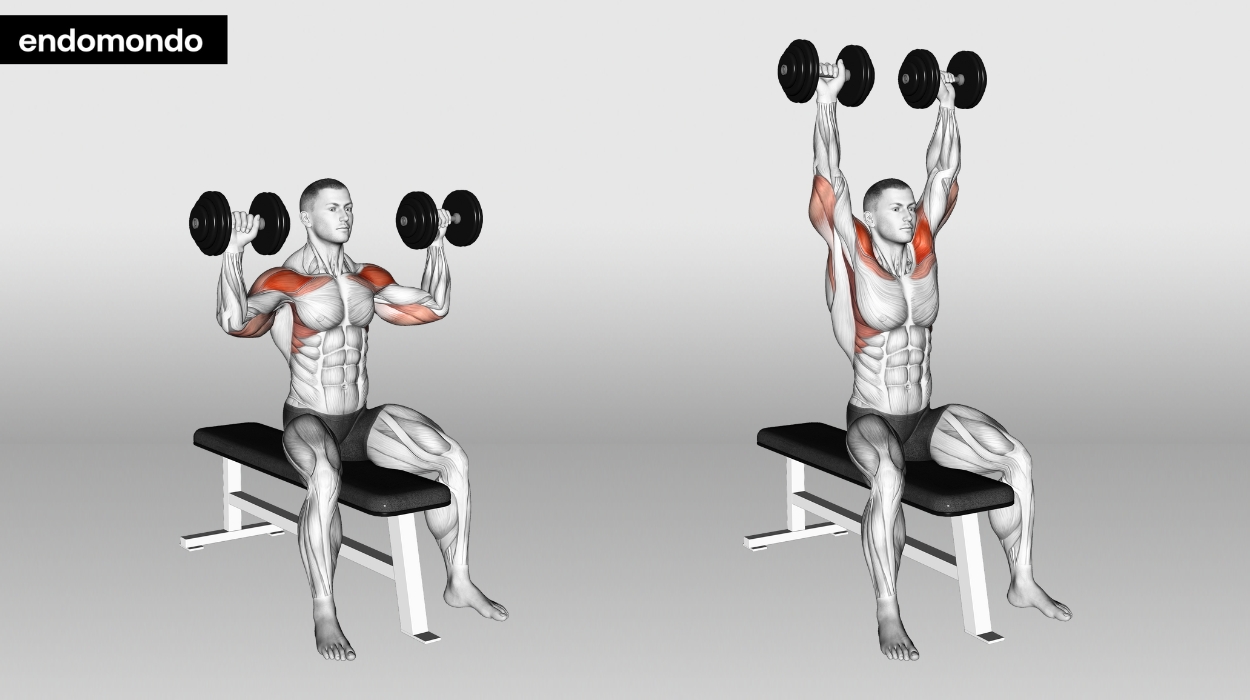
How to do:
- Begin by sitting or standing with your feet shoulder-width apart.
- Hold a dumbbell in each hand at shoulder height, palms facing forward, or use a barbell placed on your upper chest.
- Engage your core and maintain a neutral spine.
- Press the weights or barbell overhead by extending your arms fully.
- Keep your elbows slightly bent at the top of the movement.
- Lower the weights or barbell back to the starting position with control.
Tips:
- Maintain a straight back, avoid arching, and keep your core engaged throughout the exercise to protect your spine.
- Keep a slight bend in your elbows when pressing the weights overhead to avoid joint strain.
- Begin with lighter weights to ensure you can maintain good form and gradually increase the weight as you progress in strength and technique.
Optimal Sets and Reps: 3-5 sets of 12-15 reps.
If you already know your way around a weights room, remember that you can maximize calorie and[8] fat-burning results with supersets or by lifting heavier weights. You could also consider supplementing with creatine monohydrate to help you to build more muscle faster.
Best Strength Training Weight Loss Exercise Routine
Impatient to get started and enjoy the fat-burning benefits? Here’s a great workout plan to get you started. It’s simple, effective, and based on our five top strength exercises listed above.
| Exercise | Sets x Reps |
| Squats | 3-5 x 12-15 |
| Deadlifts | 3-5 x 12-15 |
| Press-ups | 3-5 x 12-15 |
| Plank | 3-5 x 12-15 |
| Shoulder Press | 3-5 x 12-15 |
First, perform a simple warm-up (5-10 minutes). The aim of the warm-up is to stimulate blood flow to work muscles with light exercises such as walking, knee-bends, or light stretches.
Next, perform the routine below. Cycle through the entire routine (five separate exercises) three to five times. Perform 12 – 15 repetitions for each set, focusing on great technique (form).
- Squats (begin with bodyweight-only squats, performed as a wall sit or free-standing squat).
- Press-ups (wall or box press-ups, moving on to full press-ups when ready).
- Deadlifts (using a light barbell).
- Shoulder Press (using a light barbell or dumbbell).
- Plank (Hold for 10 – 20 seconds, with knees on the floor, transitioning to legs straight as you progress).
End with gentle stretches, focusing specific attention on the chest, back, shoulders, and legs. You should aim to hold stretches for around 12-20 seconds to gently release tension in the muscle and to disperse lactic acid[9] as a means of minimizing the risk of stiffness one to two days after your workout.
Focus on perfect form and start with low weights. You may need a personal trainer or fitness professional to help you initially with technique. And remember, always consult your doctor if you’re beginning an exercise regime for the first time. Wear light, comfortable clothing, and stay hydrated!
Perform the routine every other day. Muscles need 24-48 hours to rest and repair.[10] When you feel ready, slowly increase weights, &/or switch up the repetitions and sets listed here for supersets. Ready to switch up your routine for a wider range of exercises? Then check out our article on muscular endurance-based exercises to learn how to push your gains even further!
Is Weight Loss Training Good?
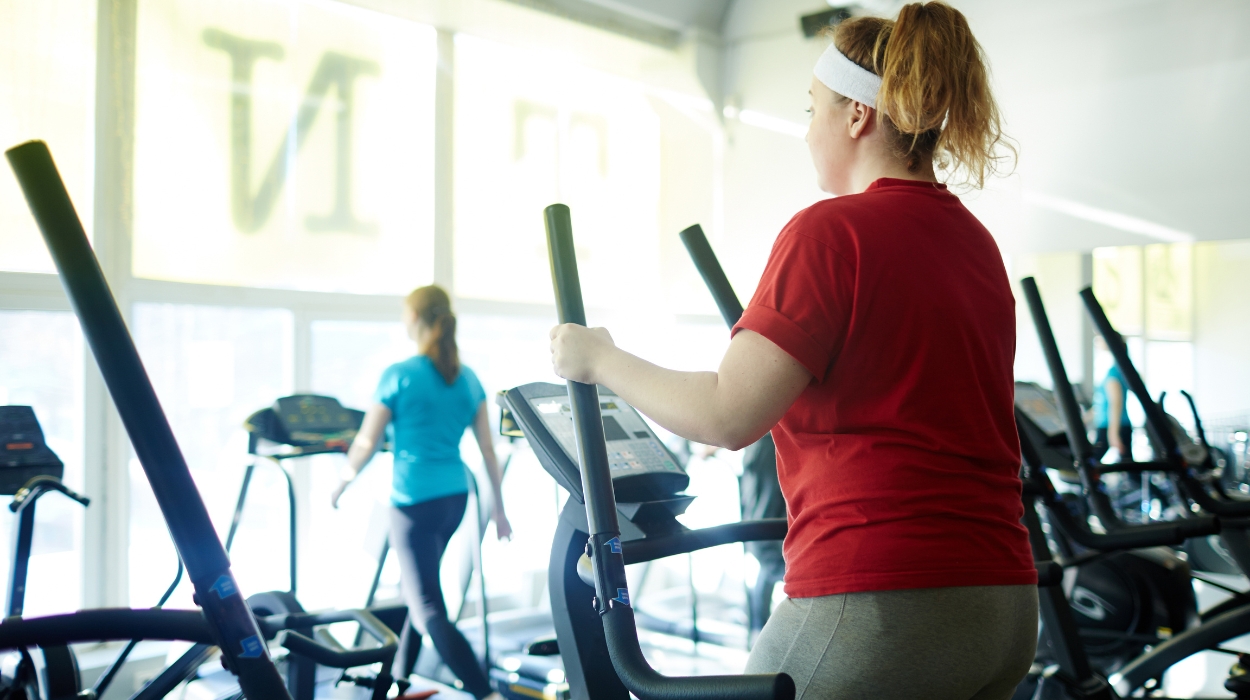
First, can a beginner burn fat by incorporating strength training exercises into their routine? Heck, yes! In fact, a review in the medical journal Sports Medicine recently stated that strength training for weight loss is a great strategy, with exercisers shedding around 1.4% of their total body fat via strength training alone. For reference, that’s a similar poundage to how much we might expect to lose using aerobic exercise like swimming or jogging. So we can say definitively that lifting weights is great for losing weight and positively altering your body fat percentage.
Resistance training helps us play the long game regarding fat loss because the more muscle we have in our body, the higher our resting metabolic rate will be. Now, our resting metabolic rate, or RMR, is the number of calories our body needs to power it at rest. The more muscle we have (which we can increase via strength training), the higher our RMR will be. And the higher it is, the more fat your body is burning[11] at rest. That ultimately means a leaner body, a faster metabolism, and a body that favors burning fat calories over storing them.
That’s exactly why a recent study found that lifting weights has been found to reduce intra-abdominal fat[12] (improving the way we look AND feel!). When strength training is performed using supersets (where sets and repetitions are performed with little to no rest in between), the fat-burning benefits increase[8] even further!
Health Benefits Of Strength Training
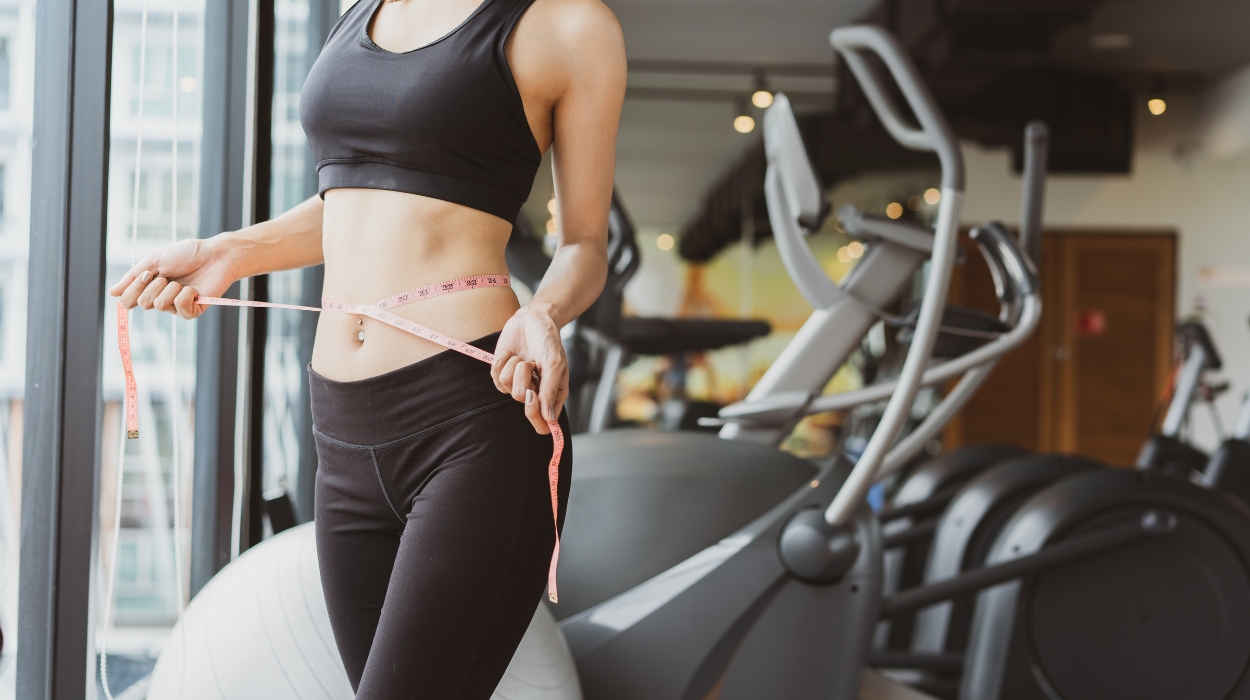
Resistance training has also been identified as a potential therapeutic intervention in treating Type II diabetes[13] and has been found to be as effective, in this regard, as cardio exercise. Researchers found that both muscular strength (hypertrophy)-focused exercise and muscular endurance-focused exercise helped mediate insulin levels and insulin sensitivity, lowered waist circumference and overall fat mass, increased lean muscle mass, improved the patient’s lipid profile, and lowered blood pressure. Strength training has also been proven to improve postmenopausal symptoms,[14] with abdominal strengthening (core) exercises also recently shown in a 2022 academic study to significantly reduce dysmenorrhea. This means that females can benefit from a whole host of health-related benefits when they head to the weight room!
First, strength training doesn’t just burn fat (although that’s a great reason, alone, to hit the weights more often!). It also plays a vital role in countering depressive symptoms,[15] with resistance training subsequently recommended as an effective adjunct treatment for depression. Exercise sessions of forty-five minutes or less exhibited the most positive outcomes in terms of depression reduction.
By boosting your metabolic rate and enabling calorie expenditure, lifting weights can also lower the risk of obesity, especially when combined with a healthy diet. For example, randomized clinical trials found that individuals incorporating resistance training into their exercise regime for one to two hours per week lowered their risk of obesity[15] by as much as 30%.
Lifting weights doesn’t just build muscle. It also strengthens bones; a 2021 meta-analysis[16] has shown strength training to be the most effective kind of exercise when it comes to improving total hip bone mineral density in patients with osteopenia and osteoporosis.
Conclusion
The bottom line is this. Work, study, school, and even a side hustle (or two) mean that your time is truly valuable. And with so many fitness fads around, you need to know that if you’re going to invest that time in working out, it needs to be 100% effective!
The great news is that science has proven the fat-burning benefits of strength training for weight loss, so strength-based workouts can be considered a great investment of your time.
So the next time you hit the gym, consider heading to the weights room (or pick up a set of dumbbells from your local sports store for great home workouts!). It’ll accelerate fat burning during workouts and help your body burn more fat at rest. And it’ll make you stronger and even offer mental and physical health benefits.
Resources
- Westcott, W.L. (2012). Resistance Training is Medicine. Current Sports Medicine Reports, [online] 11(4), pp.209–216. doi:https://doi.org/10.1249/jsr.0b013e31825dabb8.
- Shaw, I., Triplett, T. and Shaw, B.S. (2022). Resistance Training and Weight Management: Rationale and Efficacy. [online] ResearchGate. Available at: https://www.researchgate.net/publication/358588669_Resistance_Training_and_Weight_Management_Rationale_and_Efficacy.
- Luca Maestroni, Read, P., Bishop, C., Papadopoulos, K., Suchomel, T.J., Comfort, P. and Turner, A.N. (2020). The Benefits of Strength Training on Musculoskeletal System Health: Practical Applications for Interdisciplinary Care. Sports Medicine, [online] 50(8), pp.1431–1450. doi:https://doi.org/10.1007/s40279-020-01309-5.
- Serin, E. (2020). The Effect of 8 Weeks Squat Exercises Program on Body-Composition in Young Males. [online] ResearchGate. Available at: https://www.researchgate.net/publication/341379044_The_Effect_of_8_Weeks_Squat_Exercises_Program_on_Body-Composition_in_Young_Males.
- Beau Kjerulf Greer, Prawee Sirithienthad, Moffatt, R.J., Marcello, R.T. and Panton, L.B. (2015). EPOC Comparison Between Isocaloric Bouts of Steady-State Aerobic, Intermittent Aerobic, and Resistance Training. Research Quarterly for Exercise and Sport, [online] 86(2), pp.190–195. doi:https://doi.org/10.1080/02701367.2014.999190.
- Bautista, D., Durke, D., Cotter, J.A., Escobar, K.A. and Schick, E.E. (2020). A Comparison of Muscle Activation Among the Front Squat, Overhead Squat, Back Extension and Plank. International journal of exercise science, [online] 13(1), pp.714–722. Available at: https://www.ncbi.nlm.nih.gov/pmc/articles/PMC7241624/.
- Mousa Khalafi, Abbas Malandish, Rosenkranz, S.K. and Ali Asghar Ravasi (2021). Effect of resistance training with and without caloric restriction on visceral fat: A systemic review and meta‐analysis. Obesity Reviews, [online] 22(9). doi:https://doi.org/10.1111/obr.13275.
- Kelleher, A.R., Hackney, K.J., Fairchild, T.J., Keslacy, S. and Ploutz‐Snyder, L.L. (2010). The Metabolic Costs of Reciprocal Supersets vs. Traditional Resistance Exercise in Young Recreationally Active Adults. The Journal of Strength and Conditioning Research, [online] 24(4), pp.1043–1051. doi:https://doi.org/10.1519/jsc.0b013e3181d3e993.
- Miloš Dakić, Lazar Toskić, Vladimir Ilić, Saša Đurić, Milivoj Dopsaj and Jožef Šimenko (2023). The Effects of Massage Therapy on Sport and Exercise Performance: A Systematic Review. Sports, [online] 11(6), pp.110–110. doi:https://doi.org/10.3390/sports11060110.
- Gabriel Andrade Paz, Marianna, de, D., Miranda, H. and Willardson, J.M. (2021). Muscle activation and volume load performance of paired resistance training bouts with differing inter-session recovery periods. Science & Sports, [online] 36(2), pp.152–159. doi:https://doi.org/10.1016/j.scispo.2020.02.011.
- Anatoli Petridou, Aikaterina Siopi and Vassilis Mougios (2019). Exercise in the management of obesity. Metabolism, [online] 92, pp.163–169. doi:https://doi.org/10.1016/j.metabol.2018.10.009.
- Treuth, M.S., Gr, H., Tamas Kekes‐Szabo, Weinsier, R.L., Goran, M. and Berland, L.L. (1995). Reduction in intra-abdominal adipose tissue after strength training in older women. Journal of Applied Physiology, [online] 78(4), pp.1425–1431. doi:https://doi.org/10.1152/jappl.1995.78.4.1425.
- Acosta‐Manzano, P., María Rodriguez‐Ayllon, Acosta, F.M., Niederseer, D. and Niebauer, J. (2020). Beyond general resistance training. Hypertrophy versus muscular endurance training as therapeutic interventions in adults with type 2 diabetes mellitus: A systematic review and meta‐analysis. Obesity Reviews, [online] 21(6). doi:https://doi.org/10.1111/obr.13007.
- Mayr, K., Resende, G., Ulisses Kiskissian Martins, Stephano, E., Giuliana Raduan Crizol, Riera, R., Rafael Leite Pacheco and Luiza, A. (2022). Resistance training for postmenopausal women: systematic review and meta-analysis. Menopause, [online] 30(1), pp.108–116. doi:https://doi.org/10.1097/gme.0000000000002079.
- Gordon, B.R., McDowell, C.P., Hallgren, M., Meyer, J.D., Lyons, M. and Herring, M.P. (2018). Association of Efficacy of Resistance Exercise Training With Depressive Symptoms. JAMA Psychiatry, [online] 75(6), pp.566–566. doi:https://doi.org/10.1001/jamapsychiatry.2018.0572.
- Zhang, S., Huang, X., Zhao, X., Li, B., Cai, Y., Liang, X. and Wan, Q. (2021). Effect of exercise on bone mineral density among patients with osteoporosis and osteopenia: A systematic review and network meta‐analysis. Journal of Clinical Nursing, [online] 31(15-16), pp.2100–2111. doi:https://doi.org/10.1111/jocn.16101.




